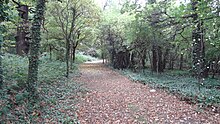
Hainault Lodge is a Local Nature Reserve in Hainult, northeast London, England and is the only one in the London Borough of Redbridge. It is owned and managed by Redbrige Council.[1][2]
History[edit]
The 6.8-hectare (17-acre) site is a small remnant of the old Hainault Forest, named after a house which was built in 1851 and demolished in 1973. In 1986 the site was acquired by Redbridge Council. It was then so overgrown that it was inaccessible, and in 1990 volunteers started to manage it. In 1995 it was designated a Local Nature Reserve.[3]
Ecology[edit]
The site is a mixture of pasture and woodland. Birds include long-tailed tits, robins, great spotted and green woodpeckers, and there are orange tip and speckled wood butterflies. Plants include butcher's broom, foxgloves and red campion. A disused boiler room has been converted into a bat hibernaculum.[1]
Location[edit]
The reserve is at the corner of Forest Road and Romford Road, but the entrance gate in Forest Road is locked and there is no public access.
References[edit]
- ^ a b "Hainault Lodge". Local Nature Reserves. Natural England. 5 March 2013. Retrieved 9 October 2013.
- ^ "Map of Hainault Lodge". Local Nature Reserves. Natural England. Retrieved 9 October 2013.
- ^ "Hainault Lodge Local Nature Reserve". Hainault Forest Website. Retrieved 9 October 2013.
External links[edit]
- "Hainault Lodge Nature Reserve". North East London Local Group. RSPB.
Well, that’s interesting to know that Psilotum nudum are known as whisk ferns. Psilotum nudum is the commoner species of the two. While the P. flaccidum is a rare species and is found in the tropical islands. Both the species are usually epiphytic in habit and grow upon tree ferns. These species may also be terrestrial and grow in humus or in the crevices of the rocks.
View the detailed Guide of Psilotum nudum: Detailed Study Of Psilotum Nudum (Whisk Fern), Classification, Anatomy, Reproduction